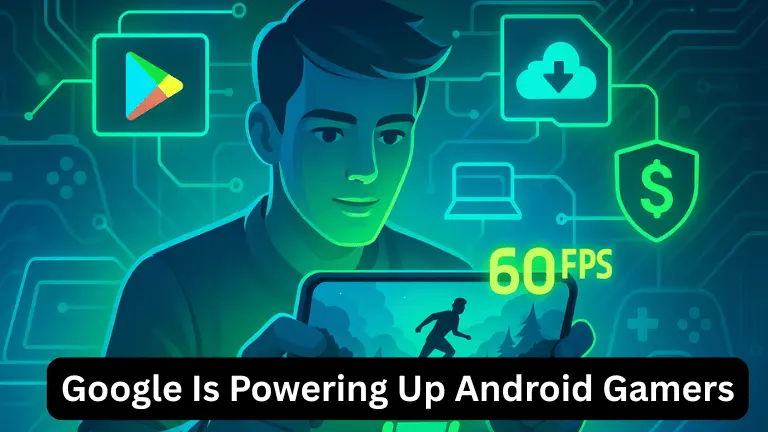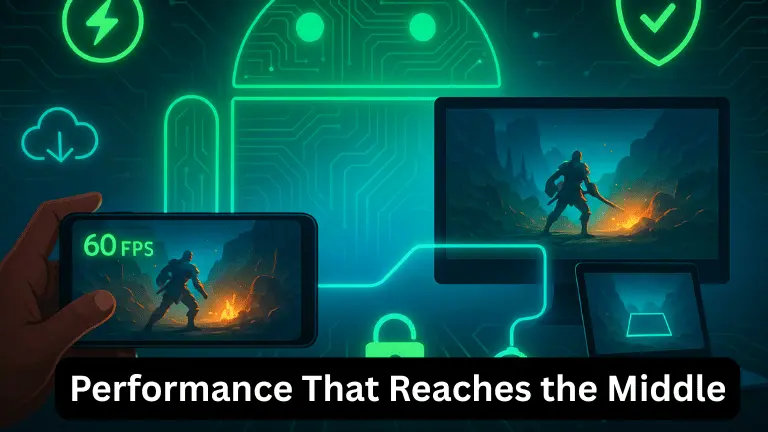Android gaming is entering a sturdier phase: smoother frame pacing, faster installs, cleaner cross-device play, and guardrails that keep matches fair. The shift is visible in week-one launches that feel stable, not experimental, and in mid-range phones that now handle big scenes without melting battery or touch latency.
Real-money titles and sport hubs also benefit from these upgrades. Brands such as 4rabet gain from quicker sign-in, safer payments, and crisper animations on modest hardware, which makes live odds, mini-games, and highlight clips feel responsive instead of risky. The same plumbing that helps an action RPG hold 60 FPS helps a score-driven app stream data without stutter.

The New Android Game Stack
Google’s recent work pushes from silicon to storefront. Game Mode and scheduler hints give the OS a clear target — keep frames consistent, not just fast. Play Asset Delivery trims initial downloads so a campaign starts while high-res packs arrive in the background. Vulkan and modern graphics paths reduce driver drama across chip makers, and controller profiles make gamepads behave predictably on phones, tablets, and TVs.
Crossing Screens Without Confusion
Play Games on PC turns phones, Chromebooks, and Windows rigs into one library. Progress syncs through Play Games Services; touch, mouse, and controller remaps are handled per device; cloud saves stop the “new phone, lost run” problem. For creators, a single SKU can now reach the couch, desk, and commute with fewer forks — and fewer tech-support headaches.
Quick Map of Upgrades and Why They Matter
| Upgrade / Program | What it means for players | Benefit for studios | Practical example |
| Game Mode & Performance Hints | More consistent FPS and touch response during play | Predictable thermals; fewer device-specific hacks | Boss fights stay smooth even as the phone warms |
| Play Asset Delivery (PAD) | Faster “Play” after a small base download | Lower day-one churn; staged content delivery | Story starts while HD textures install in the background |
| Vulkan / modern graphics path | Better efficiency, less driver variance | Higher visual ceiling on mid-range chips | Stable shadows and post-FX on $300 phones |
| Google Play Games on PC | Same account, progress, and friends across devices | One build reaches phone, Chromebook, and Windows | Finish a dungeon on desktop, continue on the train |
| Game Optimization Interventions | Auto-tuning for problem devices | Fewer hotfixes; cleaner QA matrix | OS caps a rogue setting that tanks frames |
| Play Integrity & anti-tamper | Fairer ladders; safer payments | Lower fraud; healthier economies | Cheaters flagged before a leaderboard fills |
| Play Billing + subscriptions | Clear trials and regional payment options | Higher conversion with fewer refunds | Transparent renewals; local wallets supported |
| Accessibility & input APIs | Remaps, haptics, and text size that actually work | Wider audience without custom code | Left-hand controls saved per profile |
Monetization Without Friction
Google has trimmed checkout friction and clarified receipts, trials, and regional wallets. Subscriptions now sit beside one-time unlocks with clearer renewal prompts; country-specific methods reduce cart drop-off. The result is quieter monetization: fewer surprise dialogs, faster confirmations, and better trust for live-service economies.
Performance That Reaches the Middle
The most important wins arrive on everyday hardware. Adaptive performance keeps clocks high when action spikes, then backs off to save battery during menus and travel scenes. Shader pre-compilation reduces hitches the first time a spell or explosion appears. Edge-case fixes — like predictable audio latency and steadier haptics — make even simple games feel premium.

Tools That Shorten Debug Time
Pre-launch reports in Play Console catch crashes across devices before release. Crashlytics and performance dashboards funnel the rest into clear charts, not inbox chaos. With driver updates shipping through Play, studios can fix a GPU quirk without waiting for a full OS release. QA time moves from “panic test” to “targeted verification.”
Fair Play and Safer Sessions
Ranked ladders live or die on trust. Integrity signals, device attestations, and modern anti-tamper checks make it harder to spoof inputs or mod clients. Payment flows tie into the same safety net, reducing chargebacks and unlock fraud. When players believe a match is clean and a purchase will not backfire, they stay longer and recommend more often.
Indies, AAAs, and the Middle Market
The upgrade path helps both extremes. Indies get distribution and diagnostics they could not afford to build; AAAs get a less fragmented platform for high-end art and netcode. The middle market — premium one-offs with optional DLC — benefits most: smooth installs, honest performance targets, and cross-screen saves create word-of-mouth without a live-team army.
What to Watch This Fall
Expect more games to ship with explicit frame-rate choices, per-device default presets, and “download while you play” timelines spelled out on the store page. Controller glyphs will match the hardware in hand; cloud saves will be on by default. If a title leans on real-time data — sports hubs, trading layers, or tournament lobbies — the same network plumbing that powers big shooters will make menus feel almost native.
Bottom Line
Google isn’t chasing gimmicks; it is hardening the rails. Android games now start faster, run steadier, sync progress across screens, and protect wallets and leaderboards. That foundation helps every corner of the catalog — from tactile platformers to data-heavy hubs like 4rabet — feel confident on day one and reliable on day one hundred. When infrastructure disappears into the background, the only thing left to notice is the play.